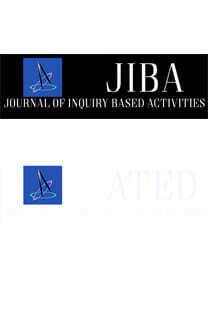KÂĞIT KATLAMA YÖNTEMİYLE DÖRTGENLERİN İNCELENMESİ
Bu makalede açıklanan etkinlik öğrencilerin kağıt katlama kullanarak dörtgenleri incelemesini sağlamak üzere kullanılmıştır. Dörtgenlerin simetri perspektifinden incelenmesine olanak tanıyan bu yöntemin uygulaması hem kolay hem de yalnızca kağıt gerektirmesi nedeniyle ekonomiktir. Ayrıca bu etkinlik dörtgenlerin özelliklerinin açı ölçer ve cetvel gibi ölçme aracı kullanmaksızın anlamlı bir şekilde öğrenilmesi için zemin hazırlama potansiyeline sahiptir. Etkinlik dörtgenlere yönelik kazanımların yanı sıra, iletişim kurma, ilişkilendirme ve akıl yürütme gibi matematiksel beceriler ile duyuşsal ve psikomotor becerilere hitap etmektedir. Burada anlatılan etkinlikler, bir ilköğretim okulunun sekizinci sınıfında uygulanmıştır. Etkinlikte temel olarak izlenen yaklaşım, dörtgenlerin kâğıt katlama yöntemi kullanılarak simetri bakış açısıyla incelenmesidir. Öğrencilerin düşüncelerini anlatırken yaptıkları açıklamalara bakıldığında kâğıt katlamanın, görsel bir ispat niteliğinde olması açısından anlamlı öğrenmeyi destekleyici katkısı açıkça görülmüştür
EXAMINING QUADRILATERALS BY PAPER FOLDING
The activity explained in this article was used to examine quadrilaterals by using paper folding. This method, facilitating the investigation of quadrilaterals with the perspective of symmetry, is both easy to use and economical. Moreover it has a potential to provide meaningful understanding for attributes of quadrilaterals without using measuring instruments such as protractor and ruler. In addition to the expectations regarding quadrilaterals, this activity addresses mathematical abilities such as communication, connection and reasoning; and affective and psychomotor abilities. The activities were implemented with eighth grade students at a public middle school. Students used paper folding to investigate quadrilaterals from the perspective of symmetry. Students’ explanations imply that paper folding, as a visual proof, supported meaningful learning
___
- Brady, K. (2008). Using Paper-Folding in the Primary Years to Promote Student Engagement in Mathematical Learning Proceedings of the 31st Annual Conference of the Mathematics Education Research Group of Australasia M. Goos, R. Brown, & K. Makar (Eds.), 77-83.
- Cipoletti, B. & Wilson, N. (2004). Turning origami into the language of mathematics. Mathematics Teaching in the Middle School, 10(1), 26-31.
- Craine, T. V. & Rubenstein, R. N. (1993). A quadrilateral hierarchy to facilitate learning in geometry. The Mathematics Teacher, 86(1), 30-36.
- DeYoung, M. J. (2009). Math in the box. Mathematics Teaching in the Middle School, 15(3), 134−141.
- Duatepe-Paksu, A. (2016). Paper Folding: A Tool in Teaching Quadrilaterals with the Perspective of Symmetry. In Katarina Zilcova (Eds.) Studia Scientifica Facultatis Paedagogicae, (pp. 34-38). Verbum Ruzomberok.
- Ellis-Davies, A. (1986). Symmetry in the mathematics curriculum. Mathematics in School, 15(3), 27-30.
- Haga, K. (2008). Origamics: mathematical explorations through paper folding. World Scientific. Keedy, M. L. (1980). The fuss about trapezoids. Mathematics Teacher, 73, 488-489.
- MEB (2013). Ortaokul matematik dersi (5, 6, 7 ve 8.Sınıflar) öğretim programı. Ankara: Talim Terbiye Kurulu Başkanlığı.
- Usiskin, Z. & Griffin, J. (2008). The classification of quadrilaterals: A study of definition. Information Age Publishing.
- Olson, A. T. (1975). Mathematics through paper folding. National Council of Teachers of Mathematics Mathematics Association of India.
- Robichaux, R. & Rodrigue, P. (2003). Using origami to promote geometric communication. Mathematics Teaching in the Middle School, 9(4), 222-229.
- Sze, S. (2005). Math and mind mapping: Origami construction. Retrieved from http://www.eric.ed.gov/ERICDocs/data/ ericdocs2sq/content_storage_01/000001 9b/80/1b/c0/ae.pdf
- Van Hiele, P. M. (1986). Structure and insight. New York: Academic Press. Wares, A. (2013). Appreciation of mathematics through origami, International Journal of Mathematical Education in Science and Technology, 44(2), 277-283.
- Wares, A. (2016). Mathematical thinking and origami. International Journal of Mathematical Education in Science and Technology, 47(1), 155-163.
- Whiteley, W. (2005). Exploring the Parallelogram through Symmetry, Unpublished manuscript. Retrieved from http://www.math.yorku.ca/~whiteley/Vis ualization.pdf.
- ISSN: 2146-5711
- Yayın Aralığı: Yılda 2 Sayı
- Başlangıç: 2011
- Yayıncı: Evrim Erbilgin
